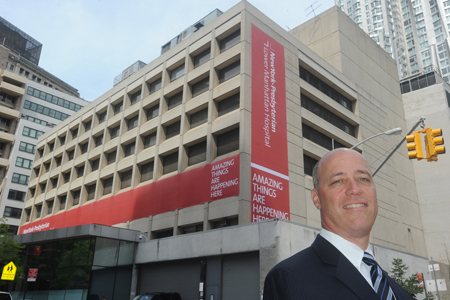Merger Resuscitates Former, Struggling NY Downtown Hospital

Emergency Department nurses, led by Arlene Eastman, right, meet for a “huddle” to review patient care. The routine is new to the hospital since the merger. Photo: Carl Glassman/Tribeca Trib
This summer, Arlene Eastman, the patient care director in the emergency department at NewYork-Presbyterian/ Lower Manhattan Hospital, got a delivery she once could only dream about.
“I got five new IV carts,” Eastman happily recalled. “We never had IV carts—they’re pretty expensive. My nurses are excited!”
The emergency room of what was formerly New York Downtown Hospital has lately been stocked with other much-needed basic equipment, from ultrasound machines to blood pressure monitors to thermometers.
“We’ve gotten so many things over the last few months,” Eastman said. “Simple equipment that we weren’t able to get previously.”
The addition of new equipment is just one of the many changes that have begun to take place since New York Downtown Hospital, Manhattan’s only hospital south of 14th Street, merged with its affiliate, NewYork-Presbyterian Hospital, in July. It is now the sixth campus of NewYork-Presbyterian, one of the largest hospital systems in the country.
For a hospital that was barely surviving, these are heady times. Administrators now talk about expansion and capital investment. They speak proudly of bringing Downtown scores of specialists and subspecialists—some of the “best doctors in the country,” they say—and building new offices.
“It’s night and day,” said Anthony Alfano, vice president of operations who had been at the financially troubled New York Downtown since 2006. “We were a small, struggling hospital. We now have a large faculty and resources that we didn’t have in the past.”
In interviews with the Trib, administrators of the newly merged hospital detailed some of the changes that patients will be seeing at the six-floor, 180-bed hospital at 170 William Street.
Already, they have carved out a separate area of the emergency room for children, built out a 14,000-square-foot space for such departments as ear, nose and throat, gastroenterology and ophthalmology, and increased nurse-to-patient ratio. The plan is to make all rooms private (now, 80 percent have two beds) in the next few years and equip them with amenities such as flat-screen TVs.
“We no longer have the restrictions of being financially strapped,” Alfano said, “so that we can get into a culture of growth. It’s always been, ‘Where are we cutting next?’”
The growth that he and other top administrators especially like to tout is the addition of doctors from Weill Cornell Medical College, who will practice out of new offices at 156 William St. And they are proud of the association between their hospital and NewYork-Presbyterian, with its impressive roster of specialists.
 “Most of the patients, we’re going to treat, care for, and they’re going to go back home,” said Michael Fosina, the hospital’s new chief operating officer, “In those instances where they need tertiary care, our doctors will pick up the phone and call their colleagues uptown and we’ll get them into the bed, into the right service at the right time.”
“Most of the patients, we’re going to treat, care for, and they’re going to go back home,” said Michael Fosina, the hospital’s new chief operating officer, “In those instances where they need tertiary care, our doctors will pick up the phone and call their colleagues uptown and we’ll get them into the bed, into the right service at the right time.”
Eastman, who has been at the hospital for 13 years, says she already sees the benefits of the merger. Nurses now attend lectures given by department heads and take NewYork-Presbyterian classes on topics such as pain assessment and sedation methods.
In the wake of Hurricane Sandy, administrators say they are looking into having their own steam-generating plant to prevent the kind of shutdown that occurred when Con Ed could not provide steam and the hospital was without heat.
(Patients were evacuated for more than a week after Sandy.) The hospital also plans to decentralize its electrical system to enable the use of power in select areas.
The merger follows years of financial turmoil at Downtown Hospital—caused, among other things, by reduced government reimbursements and a rise in labor and service costs.
According to NewYork-Presbyterian’s 2012 “certificate of need” application requesting the state’s authorization of the merger, approximately half the patients who came to the emergency room were either on Medicaid or uninsured, and the costly obstetric unit alone added more than a million dollars a year to the hospital’s overall deficit.
Its affiliation with NewYork-Presbyterian began in 2005, after it severed ties with New York University’s Langone Medical Center. With the merger this year, the hospitals become one legal entity, with a single board of trustees.
“It was our hope against hope that there would be a merger,” Alfano said, adding that few, if any, hospitals like the former New York Downtown can survive these days without an affiliation.
“They’re going to have to be a part of a network,” Alfano said, “and a network that has resources and a network that can basically feed upon one another.”
“The day of the stand-alone community hospital,” he added, “is in the past.”
